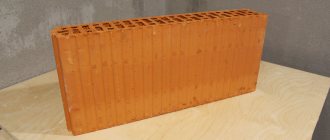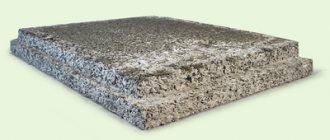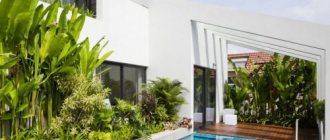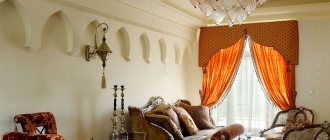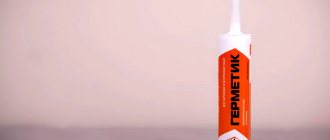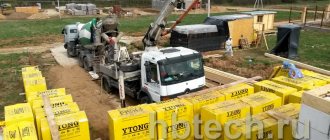HomeAbout technologyConstruction of houses from Poroterm blocks
Porotherm ceramic blocks are an environmentally friendly building material that has gained great popularity in modern construction. It has an expanded range of sizes, which allows the construction of buildings for various purposes. These can be both residential and municipal buildings. At the same time, dimensional options also have a positive effect on the minimum material residues during the construction of buildings with complex geometries. Porotherm ceramic blocks provide the ability to create any layout, which will ensure the satisfaction of any customer wishes.
Porotherm blocks are manufactured by the Wienerberger concern, which was created by Alois Miesbach in the town of Wienerberg (Austria). The start of activity was in 1918. At first, ceramic blocks were actively used only in the domestic market. But the high quality of the material was noticed by foreign companies and in 1869 building materials began to be exported outside the country. This was facilitated by the improvement of technology and the introduction of new capacities within production.
Today, the building material is a leader in the world market among analogues. Official dealers are located in more than 26 countries.
What are they?
Ceramic blocks are a construction material that appeared relatively recently. It is distinguished by durability, efficiency and strength. Ceramic blocks make warm houses that can last for more than 60 years without the need for repairs.
The Wienerberger company produces a series of ceramic blocks called POROTHERM. The material from the Austrian manufacturer has the following properties :
POROTHERM blocks have exceptional thermal conductivity properties.
For example, compared to brick, the Porotherm 38 block, which is 38 cm wide, blocks the entry of cold air in the same way as a 235 cm brick wall.To achieve the same performance, a wall made of D400 gas block should be 48 cm thick. Such properties of Porotherm blocks are manifested due to the composition, which includes additional insulating ingredients.
The material complies with the requirements of SP 50.13330.2012 for the construction of external walls and can be used almost throughout the entire territory of Russia.
- If we consider the costs of constructing walls as a whole, taking into account all additional materials, Porotherm blocks are no more expensive than aerated blocks, while surpassing them in properties.
Warm ceramics from Wienerberger do not require reinforcement and do not need long drying. Due to this, construction time is reduced. Due to the exceptional thermal insulation properties, you can do without insulation (depending on the region). - Ceramic blocks from Wienerberger are made from environmentally friendly and safe materials.
They create comfort for life, a favorable microclimate in the house, and are coated with a special composition that is not susceptible to exposure to aggressive environments. Fire resistance is one of the advantages of Porotherm blocks. When exposed to high temperatures, they do not ignite and can heat up for a long time without releasing toxic substances. - The high strength of Porotherm blocks allows the construction of buildings up to 10 floors high.
Important! Porotherm blocks do not require the use of reinforcement and a monolithic belt in front of the floors, even in high-rise construction. This sets them apart from other materials.
Manufacturer of warm ceramics
In 1819, the Wienerberger company was founded in Austria .
Since 1986, production began to expand, and the first ceramic blocks were produced. Currently, the company has more than 220 factories in 27 countries and is the largest in existence.
In Russia, the concern's production facilities are located in Kiprevo (Vladimir region) and Kurkachi (Republic of Tatarstan) . Proximity to Moscow allows us to supply materials quickly; the company has become one of the leaders in the domestic market in terms of the quality of ceramic stones.
Wienerberger's mission is to improve the quality of life of customers, continuous development using innovative technologies. The range of ceramic blocks is constantly updated.
Wide seams filled with mortar in the corners.
It also happens that at the corners, in the very place where there is no tongue-and-groove joint, the seam is over 1.5 cm, which is not acceptable. The reason for this violation is non-modular design, when the multiplicity of blocks and the presence of additional elements are not thought through in advance, before the start of masonry. Before starting masonry, it is necessary to design the walls taking into account the size of the blocks, the thickness of the joints, and additional elements. And before directly laying it on the solution, perform the “dry” layout. Haste leads to mistakes.
Specifications
Types and features of ceramic blocks from Wienerberger:
| Name | Size, mm | Strength, MPa | Thermal conductivity, λ0 | Thermal conductivity, λw | Purpose |
| Porotherm 12 | 500x120x219 | 10 | 0,18 | 0,24 | For laying partitions between rooms in 1 row, a durable material that can withstand hanging structures. |
| Porotherm 20 | 400x200x219 | 10 | 0,202 | 0,228 | For filling openings in monolithic buildings on frames. |
| Porotherm 25 | 375x250x219 | 10 | 0,198 | 0,220 | For internal and external load-bearing walls. |
| Porotherm 25M | 375x250x219 | 10 | 0,198 | 0.220 | New with thickened walls. Suitable for external walls for insulation, for walls between apartments in high-rise buildings, for internal load-bearing walls in private houses. |
| Porotherm 30 | 250x300x219 | 20 | 0,23 | 0,27 | For internal load-bearing walls. |
| Porotherm 38 | 250x380x219 | 10 | 0,133 | 0,144 | For external and internal walls. |
| Porotherm 38 Thermo | 250x380x219 | 7,5 | 0,105 | 0,118 | Suitable for laying internal and external walls up to 5 floors without reinforcement. |
| Porotherm 44 | 250x440x219 | 10 | 0,135 | 0,144 | For interior and exterior walls. |
| Porotherm 44 GL (Green Line) | 250x440x219 | 10 | 0,145 | 0,16 | For the construction of external walls of private houses without insulation. |
| Porotherm 51 | 250x510x219 | 10 | 0,138 | 0,148 | For external and internal walls. |
| Porotherm 8 | 500x80x219 | 10 | — | — | Thin stones for interior partitions. |
Loose connection of vertical seams.
The tongue-groove connection must be made as tightly as possible, and for this it is necessary to follow simple masonry rules. The foundation of the wall must be level; if a slope of the foundation or floor surface is detected, it must be leveled with mortar, starting from the highest point of the base surface. Each row must be checked against the level and the rail and adjusted using a rubber hammer.
Pros and cons of Porotherm ceramic block from Wienerberger
Advantages of Porotherm ceramic blocks:
- Thermal insulation properties .
Ceramic stones from the Austrian manufacturer are constantly being improved, the latest developments are made using a more effective form of voids, and the porosity of the ceramic shard has been increased. As a result, the thermal conductivity of the porous material is tens of times better than that of brick. Pores in clay form small sawdust, which creates up to 30% of free space inside the material. The strength of the blocks remains at a high level, at the same time the elements are light in weight, which facilitates the laying process. - Ceramic blocks create a favorable microclimate in the house .
The temperature inside is always comfortable, there is no dampness or cold bridges (subject to the rules for laying the material). They are hypoallergenic and do not emit toxic substances when heated. Creating walls from ceramic stone from Wienerberger is a guarantee of silence; the material has excellent soundproofing properties. The properties of the walls make it possible to avoid the effect of a thermos; excess moisture evaporates in time. With an average humidity of 30-50%, the indoor temperature is maintained at 20-25 degrees. - The material is durable and is processed at a temperature of 900 degrees . Hardened ceramic blocks are resistant to destruction and do not tolerate the effects of chemicals from the external environment. They have excellent fire resistance.
- The high strength of the material allows you to do without reinforcement and additional strengthening . Ceramic stones marked M100 can withstand 400 kg of weight, which is enough to build a house more than 5 floors high.
The Wienerberger company operates in accordance with GOST 530-2012 standards. For production, high-quality, purified clay, natural sawdust and tripoli are used, which create a safe material.
The main advantage of Porotherm ceramic blocks is thermal comfort and excellent vapor permeability. The houses are warm in winter and cool in summer.
Advantages of Porotherm ceramic blocks:
Disadvantages of the material:
- Price .
The cost of the material is higher than that of brick or gas blocks. But if you calculate the construction costs as a whole, the total price will be about 5% more. Ceramic stones do not require reinforcement or insulation, which saves a lot of money. There is no need to wait long for the masonry to dry; you can immediately begin finishing. - Sensitivity to moisture . The material is hygroscopic, like brick, high-quality waterproofing is required at all stages of construction, starting from the connection of the first row and the foundation. Store ceramic blocks in polyethylene or under a canopy so that wet precipitation does not damage the material.
- Fragility . The thin walls of ceramic blocks are easily damaged during transportation. Therefore, the manufacturer packages the blocks in pallets and protects them as much as possible from external mechanical influence.
Reviews
Owners of houses made from Porotherm ceramic blocks note:
- Preservation of heat inside the house in any weather and wind force.
- In terms of price-quality-thermal insulation-strength ratio, the stones from this manufacturer are among the best on the market.
- Insulation and reinforcement in most cases is really not required.
- Excellent service from the manufacturer, competent advice from managers.
- The speed of construction increases, the elements fit well together, and little mortar is required.
- Suitable for fans of environmentally friendly housing made from natural materials.
- To attach furniture to the wall, you need long dowels due to the fragility of the material.
Many reviews about the Porotherm ceramic block can be found here and here. Consumers also shared their opinions about construction from this material in this and this publication.
Benefits of working with us
| Fixed construction cost without changes | Honest, transparent estimate and free analysis of competitor estimates |
| Free individual architectural design when ordering construction | Own experience of living and operating country houses |
| Demo hall of construction technologies in the office with consultations | Successful work in the construction market since 1990 |
A house made of porotherm has many advantages:
- the walls are warm and do not require insulation, and also help minimize heating costs in winter;
- good soundproofing properties allow not only to avoid noise from outside, but also to make all interior rooms quiet;
- thanks to the high vapor permeability of the material, houses made of porotherm “breathe”, so they have a correct and healthy microclimate;
- the material is environmentally friendly, at the same time it is not affected by fungi and mold, moisture and ultraviolet radiation;
- The smooth surface of the masonry makes it possible to use a variety of finishing materials, without the need to carry out preliminary leveling of the walls.
average price
Average cost of Porotherm ceramic blocks in Russia:
| Name | Price, rub/piece |
| Porotherm 12 | 70 |
| Porotherm 20 | 108 |
| Porotherm 25 | 100 |
| Porotherm 25M | 119 |
| Porotherm 30 Thermo (thermo) | 110 |
| Porotherm 38 | 110 |
| Porotherm 38 Thermo | 115 |
| Porotherm 44 | 117 |
| Porotherm 44 GL (Green Line) | 120 |
| Porotherm 51 | 129 |
| Porotherm 8 | 50 |
Our projects of houses made from Porotherm blocks
Project 54-88
calculate the cost | Project 54-59
calculate the cost | Project 38-33
calculate the cost | Project 38-44
calculate the cost |
Project 38-27
calculate the cost | Project 36-91
calculate the cost | Project 53-30
calculate the cost | Project 55-26
calculate the cost |
Catalog of ready-made projects from Porotherm blocks>>
How do you know if Porotherm is right for you?
If you:
- take care of yourself and your loved ones and look for environmentally friendly materials;
- you want the house to be comfortable in any weather - warm in cold weather, cool in hot weather;
- want to build a house 2-3 times faster than your neighbor, and also save on materials;
- Do you dream of a reliable, durable home in which even your great-grandchildren can live without problems?
And:
- value a creative, unconventional approach, and you need to find materials that will allow the wildest architectural fantasies to become reality;
- After the completion of construction, you don’t want to see cracks on the walls that formed during the shrinkage process, and mold that appears on the walls due to humidity;
- and dream of living in peace and quiet,
Then Porotherm is what you need!
Porotherm. Resistant to everything
Are you afraid that after several years the house will begin to collapse due to frosts, thaws and the constant “drying out” of the walls by heating?
Don't worry - you just need to consider the frost resistance of the selected building materials. It characterizes the ability of a material in a water-saturated state to withstand alternate freezing and thawing without destruction.
Frost resistance is designated by the letter F and is determined experimentally. To do this, the ceramic block is immersed in water for 4 hours, and then also placed in the freezer for 4 hours.
This procedure simulates 1 cycle, and it is repeated until the ceramic brick begins to lose its characteristics. Thus, Porotherm products can withstand 50 such cycles.
Of course, there is no way that the house will be subjected to the same conditions as during the experiment. Therefore, Porotherm walls will remain durable for centuries.

